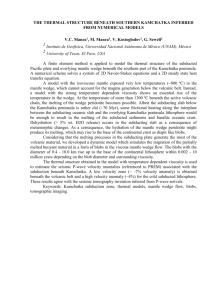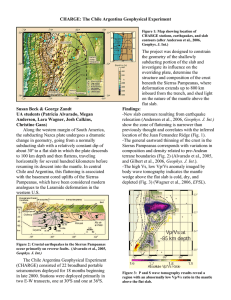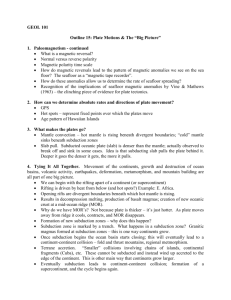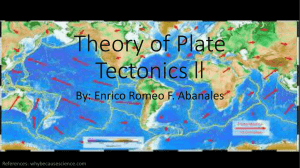Mantle Flow at a Slab Edge: Seismic Anisotropy in the
advertisement
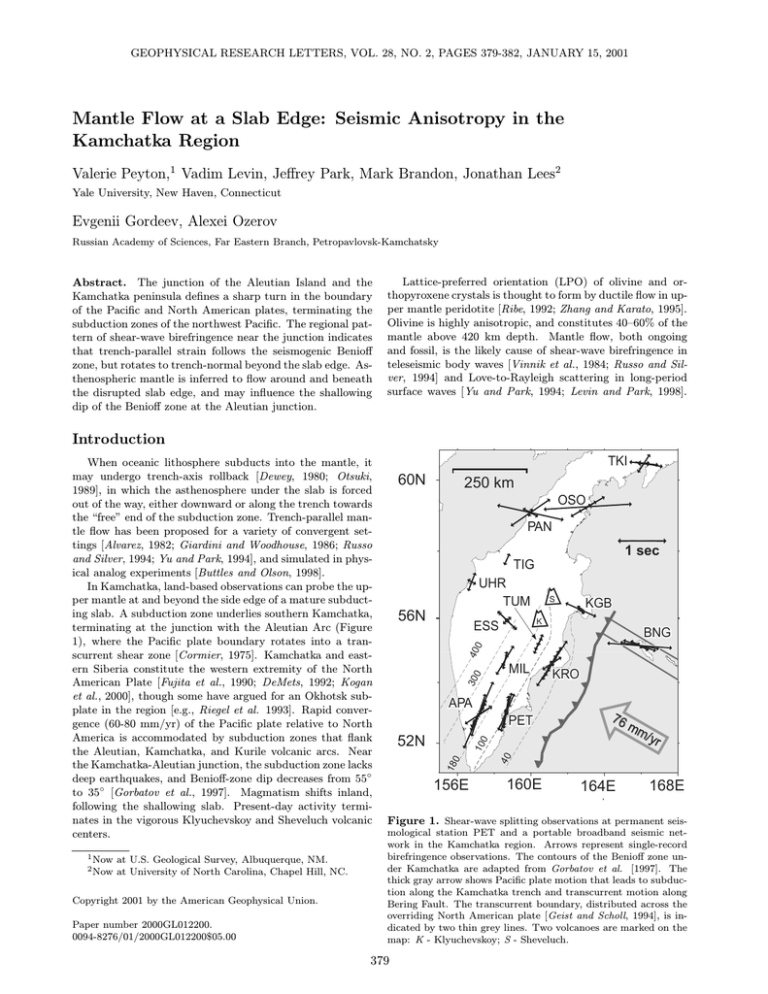
GEOPHYSICAL RESEARCH LETTERS, VOL. 28, NO. 2, PAGES 379-382, JANUARY 15, 2001 Mantle Flow at a Slab Edge: Seismic Anisotropy in the Kamchatka Region Valerie Peyton,1 Vadim Levin, Jeffrey Park, Mark Brandon, Jonathan Lees2 Yale University, New Haven, Connecticut Evgenii Gordeev, Alexei Ozerov Russian Academy of Sciences, Far Eastern Branch, Petropavlovsk-Kamchatsky Abstract. The junction of the Aleutian Island and the Kamchatka peninsula defines a sharp turn in the boundary of the Pacific and North American plates, terminating the subduction zones of the northwest Pacific. The regional pattern of shear-wave birefringence near the junction indicates that trench-parallel strain follows the seismogenic Benioff zone, but rotates to trench-normal beyond the slab edge. Asthenospheric mantle is inferred to flow around and beneath the disrupted slab edge, and may influence the shallowing dip of the Benioff zone at the Aleutian junction. Lattice-preferred orientation (LPO) of olivine and orthopyroxene crystals is thought to form by ductile flow in upper mantle peridotite [Ribe, 1992; Zhang and Karato, 1995]. Olivine is highly anisotropic, and constitutes 40–60% of the mantle above 420 km depth. Mantle flow, both ongoing and fossil, is the likely cause of shear-wave birefringence in teleseismic body waves [Vinnik et al., 1984; Russo and Silver, 1994] and Love-to-Rayleigh scattering in long-period surface waves [Yu and Park, 1994; Levin and Park, 1998]. Introduction 1 Now 2 Now at U.S. Geological Survey, Albuquerque, NM. at University of North Carolina, Chapel Hill, NC. Copyright 2001 by the American Geophysical Union. Paper number 2000GL012200. 0094-8276/01/2000GL012200$05.00 TKI 60N 250 km OSO PAN 1 sec TIG UHR TUM 56N S KGB K ESS 30 0 40 0 BNG MIL KRO APA PET 76 156E mm /yr 40 10 0 52N 18 0 When oceanic lithosphere subducts into the mantle, it may undergo trench-axis rollback [Dewey, 1980; Otsuki, 1989], in which the asthenosphere under the slab is forced out of the way, either downward or along the trench towards the “free” end of the subduction zone. Trench-parallel mantle flow has been proposed for a variety of convergent settings [Alvarez, 1982; Giardini and Woodhouse, 1986; Russo and Silver, 1994; Yu and Park, 1994], and simulated in physical analog experiments [Buttles and Olson, 1998]. In Kamchatka, land-based observations can probe the upper mantle at and beyond the side edge of a mature subducting slab. A subduction zone underlies southern Kamchatka, terminating at the junction with the Aleutian Arc (Figure 1), where the Pacific plate boundary rotates into a transcurrent shear zone [Cormier, 1975]. Kamchatka and eastern Siberia constitute the western extremity of the North American Plate [Fujita et al., 1990; DeMets, 1992; Kogan et al., 2000], though some have argued for an Okhotsk subplate in the region [e.g., Riegel et al. 1993]. Rapid convergence (60-80 mm/yr) of the Pacific plate relative to North America is accommodated by subduction zones that flank the Aleutian, Kamchatka, and Kurile volcanic arcs. Near the Kamchatka-Aleutian junction, the subduction zone lacks deep earthquakes, and Benioff-zone dip decreases from 55◦ to 35◦ [Gorbatov et al., 1997]. Magmatism shifts inland, following the shallowing slab. Present-day activity terminates in the vigorous Klyuchevskoy and Sheveluch volcanic centers. 160E 164E 168E Figure 1. Shear-wave splitting observations at permanent seismological station PET and a portable broadband seismic network in the Kamchatka region. Arrows represent single-record birefringence observations. The contours of the Benioff zone under Kamchatka are adapted from Gorbatov et al. [1997]. The thick gray arrow shows Pacific plate motion that leads to subduction along the Kamchatka trench and transcurrent motion along Bering Fault. The transcurrent boundary, distributed across the overriding North American plate [Geist and Scholl, 1994], is indicated by two thin grey lines. Two volcanoes are marked on the map: K - Klyuchevskoy; S - Sheveluch. 379 380 PEYTON ET AL: MANTLE FLOW AT THE KAMCHATKA SLAB EDGE 0 25 0 R 53.8 104.7 25 R 57.1 105.1 R T T R T T ESS TUM 23.9 0.44 F S S F S 0 S 25 F 0 125.5 0.14 25 F Figure 2. Shear wave splitting examples for stations TUM (left four panels) and ESS (right four panels). For each station, the upper left panel graphs the horizontal waveforms of the observed shear phase, rotated into the radial-transverse coordinate frame. Birefringence in the waveform is manifested by ellipticity of the particle motion (upper right panels). The numbers in the particle-motion box are back-azimuth and epicentral distance, in degrees. For each station, the lower left panel graphs the waveforms rotated into the fast and slow polarizations, with the slow component advanced by the estimated splitting delay. The lower right panel graphs corrected near-rectilinear particle motion. The numbers in the particle-motion box are fast-polarization azimuth in degrees and time delay (in seconds) between fast and slow components. These effects are absent if the anisotropy has a vertical axis of symmetry, and so are indicators of lateral mantle flow. SKS Splitting in Kamchatka We analyzed data from station PET of the Global Seismographic Network and 12 broad-band seismic observatories deployed in Kamchatka from mid-1998 to mid-1999. Figure 1 plots shear wave splitting observations for core-refracted shear phases discernible above the noise, typically after lowpassing at periods T > 5 s. At some stations (KRO, OSO) only waveforms lowpassed at T > 10 s were useful, due to surf noise. Many SKS observations involved phases arriving from the northeast (sources in Central and South America). Splitting observations at other backazimuths originated in the southern Pacific, central Atlantic and Indian Oceans. An electronic supplement file lists all observations of shear wave splitting for each station, with directions of approach and uncertainty estimates, performed using the cross-correlation technique described in Levin et al. [1999]. The small number of observations prevent us from interpreting backazimuth and incident-angle variations in splitting values, behavior that could resolve depth variation in anisotropic parameters [Levin et al., 1999]. However, fastpolarization direction is consistent within groups of adjacent stations, and the inferred orientation differences can be confirmed in simultaneous SKS waveforms from single events (Figure 2). Shear-wave birefringence (splitting) parameters for SKS phases fall into two groups. Stations located above the Benioff zone (APA, PET, KRO, MIL, TUM) show a trenchparallel fast-polarization direction. Stations away from the slab show other fast-polarization orientations. Trenchnormal directions at sites near the Kamchatka-Aleutian junction (ESS, KGB, BNG) rule out a continuous trenchparallel mantle fabric beyond the plate boundary corner, as might be expected for strong trench-parallel flow. Trenchnormal splitting at ESS, in particular, argues that the slab does not extend downdip beyond its seismogenic zone. This interpretation agrees with seismic tomography studies [Gorbatov et al., 2000] which report low seismic velocity beneath central Kamchatka. Few SKS phases exhibit splitting delay times δt > 1 s, and these are mostly recorded at the northern stations. Typically, splitting delays of 0.4 < δt < 0.8 s, with formal uncertainties of 0.1–0.3 s, define the fastpolarization trends in Figure 1. Figure 2 shows a clear SKS phase simultaneously observed at stations TUM and ESS, yielding different birefringence parameters: trench-parallel fast-polarization and a delay of 0.44 sec at TUM; and trenchnormal fast-polarization and a very small delay at ESS. The product of anisotropy and layer thickness produces the splitting delay δt. If we assume 3% anisotropy with mean Vs = 4.5 km/s, a shear wave that traversed 90 km would accumulate δt = 0.6 s, consistent with a typical δt estimate from our data set. For the same δt, a thicker strained layer would imply weaker anisotropy. Previous “source-side” estimates of mantle anisotropy near Kamchatka [Kaneshima and Silver, 1992; Fischer and Yang, 1994] were based on the differential splitting of teleseismic shear-phase pairs (e.g., S and sS) recorded at stations in North America. Our splitting delays δt are significantly smaller than the source-side estimates, which range between 1 and 2.35 s. Therefore the level and/or extent of anisotropic mantle beneath Kamchatka is less than indicated by earlier studies. Discussion Two lines of evidence support the notion that the trenchparallel SKS splitting at APA, PET, KRO, MIL, and TUM originates below the Benioff zone: weak local-S splitting and the deformation of mantle xenoliths. S waves from earthquakes within the Kamchatka Benioff zone traverse the supra-slab mantle wedge and crust and do not sample anisotropy within and beneath the slab. For PET and APA, the observed local-S fast-polarization axes vary greatly, with splitting delays δt = 0.1 − 0.3 s that are much smaller than kamchatka pa cific plate asthenospher e Figure 3. Schematic diagram for slab-edge mantle flow suggested by shear-wave splitting observations from a portable seismic network in Kamchatka. Mantle extension is trench-parallel beneath the slab itself, driven by asthenospheric flow as the slab descends and retreats from the Eurasian landmass. At stations above the slab, shear-wave splitting is trench-parallel. Near the tattered slab edge, asthenosphere flows from beneath the Pacific Plate to beneath the overriding plate. Here the olivine LPO aligns its fast axis with the flow to become trench-normal. PEYTON ET AL: MANTLE FLOW AT THE KAMCHATKA SLAB EDGE teleseismic splitting values. Similar weak splitting and irregular polarization in local S-waves for Kamchatka earthquakes was found by Guseva et. al. [1991]. Mantle xenoliths found at Avachinsky Volcano near PET [Graybill et al., 1999] lack the kind of rock fabric that develops in a simpleshear flow. The xenoliths do not provide evidence for either a subduction-induced corner flow or a trench-parallel shear flow in the mantle wedge. Weak mantle-wedge fabric is consistent with other subduction-zone observations where backarc spreading is weak [Fischer et al., 1998; Wiemer et al., 1999],and with the tank experiments of Buttles and Olson [1998]. We interpret the anisotropy implied by SKS splitting in terms of trench-parallel asthenospheric extension and/or flow beneath the Pacific plate. It is unlikely that the strain resides entirely in the slab itself, whether due to along-trench extension or fossil fabric. Present-day slab extension would not occur without strain in the adjoining asthenosphere. As for fossil slab fabric, an extrapolation of magnetic anomalies beyond the Cretaceous “quiet” magnetic zone predicts that the paleospreading direction within the slab under Kamchatka should be near-normal to the trench. The anisotropic fast-polarization directions for stations that border the shallow seismogenic zone are trench-normal, suggesting strain and/or mantle flow across the plate boundary. Splitting at BNG is likely influenced by the transcurrent deformation along the western Aleutians [Cormier, 1975; Geist and Scholl, 1994]. Splitting at KGB and ESS argues for flow around and beneath the tattered slab edge. North of the Aleutian junction along an extinct subduction zone bordering the Bering Sea [Seliverstov, 1997], splitting at PAN, OSO and TKI is larger and scattered, but inconsistent with any trench-parallel flow. Though 1.3 Ma volcanic rocks have been reported in the region [Honthaas et al. 1995], Hochstaedler et al. [1994] argue from geochemical evidence that subduction in northern Kamchatka had weakened or halted during the eruption of the Valovayam volcanic field near OSO at 6–8 Ma. Trench-normal fast-polarization near the KamchatkaAleutian corner could indicate the shearing of asthenosphere as the slab falls through it. Trench regression would also induce asthenospheric flow from the Pacific to the North American side of the plate boundary (Figure 3). If trench regression occurs, it is likely smaller than near the Lau Basin and the Phillipine Sea, where back-arc spreading is vigorous. However, the Sea of Okhotsk is thought to be underlain by extended continental lithosphere [Gnibidenko and Khvedchuk, 1982; Melankholina, 1998], and a central graben divides southern Kamchatka into east and west mountain ranges. Weaker slab regression is plausible, given the small SKS splitting delays in Kamchatka. In tank experiments to simulate the regression of a dipping slab through the mantle, Buttles and Olson [1998] observed significant displacement of asthenosphere beneath the slab as well as around it laterally. Beneath Kamchatka, where Davaille and Lees [2000] argue that the slab edge may have been lost through small-scale convective instability, such “pass-through” flow is likely. The change in Benioff-zone dip near the Aleutian corner could be facilitated by the loss of the downdip load and a lofting of the plate edge by mantle flow beneath it. A consequent shallowing of the plate edge and the supra-slab mantle would induce pressure-release volcanism, and could be partly responsible 381 for the voluminous Klyuchevshoy volcanism, the inferred contribution of “adakite” slab-derived melts to Sheveluch volcanism [Kepezhinskas et al 1997; Yogodzinski et al 2000], and the widening of the central Kamchatka graben opposite the plate corner. Acknowledgments. Comments from two reviewers clarified some points. This research was supported by the NSF grant EAR-9614639. Support from the Kamchatka ExperimentalMethodical Seismic Department (V. Chebrov, O. Dontsov, E. Tokarev, V. Stepanov, V. Sinitsyn, N. Titkov, I. Semchenko) and the Institute of Volcanology (V. Gorelchik, A. Osipenko, L. Osipenko) was critical to the success of the field campaign. Matthew Fouch, Paul Friberg, Noel Barstow and Doug Johnson facilitated the use of PASSCAL seismic equipment from the Incorporated Research Institutions for Seismology. We used GMT software [Wessel and Smith, 1991] to prepare figures. References Alvarez, W., Geological evidence for the geographical pattern of mantle return flow and the driving mechanism of plate tectonics, J. Geophys. Res., 87, 6697–6710, 1982. Buttles, J. and P. Olson, A laboratory model of subduction zone anisotropy, Earth Planet. Sci. Lett., 164, 245–262, 1998. Cormier, V. F., Tectonics near the junction of the Aleutian and Kuril-Kamchatka arcs and a mechanism for middle Tertiary magmatism in the Kamchatka basin, Geol. Soc. Am. Bull., 86, 443–453, 1975. Davaille, A., and J. M. Lees, Thermal modeling in torn, subducted plate edges Geophys. Res. Lett., submitted 2000. DeMets, C., A test of present-day plate geometries for northeast Asia and Japan, J. Geophys. Res., 97, 17627–17635, 1992. Dewey, J. F., Episodicity, sequence, and style at convergent plate boundaries, in The Continental Crust and its Mineral Deposits, D. W. Strangway, ed., Geol. Assoc. Can., Spec. Pap., 20, 553–573, 1980. Fischer, K. M. and X. Yang, Anisotropy in Kuril-Kamchatka subduction zone structure, Geophys. Res. Lett., 21, 5–8, 1994. Fischer, K. M., M. Fouch, D. Wiens and M. Boettcher, Anisotropy and flow in Pacific subduction zone back-arcs, Pure Appl. Geophys., 151, 463–475, 1998. Fujita, K., D. B. Cook, H. Gasgawa, D. Forsyth and R. Wetmiller, Seismicity and focal mechanisms of the Arctic region and the North American plate boundary in Asia, in The Arctic Ocean Region, A. Grantz, L. Johnson and J. F. Sweeney (Eds.) GSA, Boulder, 1990. Geist, E. L. and D. W. Scholl, Large-scale deformation related to the collision of the Aleutian arc with Kamchatka, Tectonics, 13, 538–560, 1994. Giardini, D. and J. H. Woodhouse, Horizontal shear flow in the mantle beneath the Tonga arc, Nature, 319, 551–555, 1986. Gnibidenko, H. S., and I. I. Khvedchuk, The tectonics of the Okhotsk Sea, Mar. Geol., 50, 155–198, 1982. Gorbatov, A., V. Kostaglodov, G. Suarez, and E. Gordeev, Seismicity and structure of the Kamchatka subduction zone, J. Geophys. Res., 102, 17883–17898, 1997. Gorbatov, A., A. Widiyantoro, Y. Fukao, and E. Gordeev, Signature of remnant slabs in the North Pacific from P -wave tomography, Geophy. Journal Int. 142, 27–36, 2000. Graybill, J., M. T. Brandon, and P. K. Kepezhinskas, Olivine lattice-preferred orientation in xenoliths from the mantle wedge beneath the Southern Kamchatka volcanic arc (abstract), Eos Trans. AGU, 80, F926, 1999. Guseva, E. M., A. A. Gusev, and L. S. Oskorbin. A software package for earthquake data processing: experimental application to strong motion record. Volcanology and Seismology, 11, 648-670, 1991. Hochstaedler, A. G., P. K. Kepezhinskas, M. J. Defant, M. S. Drummond, and H. Bellon, On the tectonic significance of arc volcanism in northern Kamchatka, J. Geology, 102, 639–654, 1994. 382 PEYTON ET AL: MANTLE FLOW AT THE KAMCHATKA SLAB EDGE Honthaas, C., Bellon, H., Kepezhinskas, P. K., and R. C. Maury, New 40 K-40 Ar dates for the Cretaceous-Quaternary magmatism of Northern Kamchatka (Russia), C. R. Acad. Sci. Paris, Serie II, 320, 197–204. 1995. Kaneshima, S., and P. G. Silver, A search for source-side anisotropy, Geophys. Res. Lett., 19, 1049–1052, 1992. Kepezhinskas, P. K., F. McDermott, M. J. Defant, A. Hochstaedler, M. S. Drummond, C. J. Hawkesworth, A. Koloskov, R. C. Maury, and H. Bellon, Trace element and Sr-Nd-Pb isotopic constraints on a three-component model of Kamchatka Arc petrogenesis, Geochim. Cosmochim. Acta, 61, 577–600, 1997. Kogan, M. G, G. M. Steblov, R. W. King, T. A. Herring, D. I. Frolov, S. G. Egorov, V. Ye. Levin, A. Lerner-Lam, and A. Jones, Geodetic constraints on the rigidity and relative motion of Eurasia and North America, Geophys. Res. Lett., 27, 2041– 2044, 2000. Levin, V., and J. Park, Quasi-Love phases between Tonga and Hawaii: observations, simulations and explanations, J. Geophys. Res., 103, 24321–24331, 1998. Levin, V., W. Menke and J. Park, Shear wave splitting in Appalachians and Urals: a case for multilayered anisotropy, J. Geophys. Res., 104, 17975–17994, 1999. Melankholina, E. N., The types of back-arc basins in East Asia: Tectonic, magmatic, and geodynamic aspects, Geotectonics, 32, 453–467, 1998. Otsuki, K., Empirical relationships among the convergence rate of plates, rollback rate of trench axis and island-arc tectonics, Tectonophys., 159, 73-94, 1989. Ribe, N. M., On the relationship between seismic anisotropy and finite strain, J. Geophys. Res., 97, 8737–8748, 1992. Riegel, S. A., Fujita, K., Koz’min, B. M., Imaev, V. S., and D. B. Cook, Extrusion tectonics of the Okhotsk Plate, northeast Asia, Geophys. Res. Lett., 20, 607–610, 1993. Russo, R. M. and P. G. Silver, Trench-parallel flow beneath the Nazca Plate from seismic anisotropy, Science, 263, 1105–1111, 1994. Seliverstov N. I., Geodynamic evolution of the junction zone of the Kuril-Kamchatka and Aleutian island arcs (in Russian), Vulkanologiya i Seysmologiya., 3, 12–17. 1997. Vinnik, L. P., Kosarev, G. L., and Makeyeva L. I., Anisotropy of the lithosphere according to the observations of SKS and SKKS waves (in Russian), Doklady Akademii Nauk SSSR, 278, 1335–1339, 1984. Weimer, S., G. Tytgat, M. Wyss, and U. Duenkel, Evidence for shear-wave anisotropy in the mantle wedge beneath southcentral Alaska, Bull. Seismol. Soc. Am., 89, 1313–1322, 1999. Wessel, P., and W. H. F. Smith, Free software helps map and display data, Eos Trans. AGU, 72, 441, 1991. Yogodzinski, G. M., J. M. Lees, T. G. Chur-ikova, F. Dorendorf, and O. N. Volynets, Slab edge effects on arc magma geochemistry: Evidence of a torn Pacific plate beneath Kamchatka and the Aleutians, Nature, in press 2000. Yu, Y., and J. Park, Hunting for azimuthal anisotropy beneath the Pacific Ocean region, J. Geophys. Res., 99, 15399–15421, 1994. Zhang, S., and S.-I. Karato, Lattice preferred orientation of olivine aggregates deformed in simple shear, Nature, 375, 774– 777, 1995. Valerie Peyton, U.S.G.S., Seismo Lab, Bldg 10002, Kirtland AFB-East, Albuquerque, NM 87115 Vadim Levin, Jeffrey Park, and Mark Brandon, Dept. of Geology and Geophysics, Box 208109, Yale Univ., New Haven, CT 06520 Jonathan Lees, Department of Geological Sciences, Campus Box 3315, Mitchell Hall, Univ. of North Carolina, Chapel Hill, NC 27599-3315 Evgenii Gordeev and Alexei Ozerov, Russian Academy of Sciences, Far Eastern Branch, Petropavlovsk-Kamchatsky (Received August 12, 2000; revised October 26, 2000; accepted October 31, 2000.)
